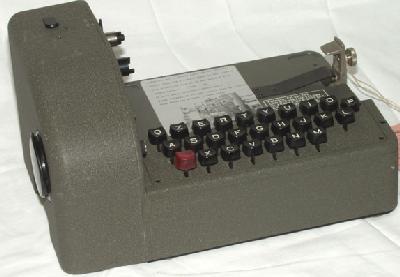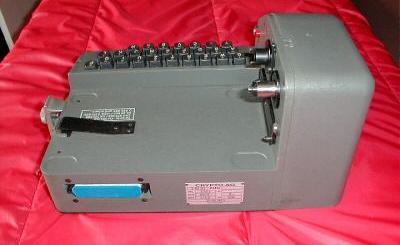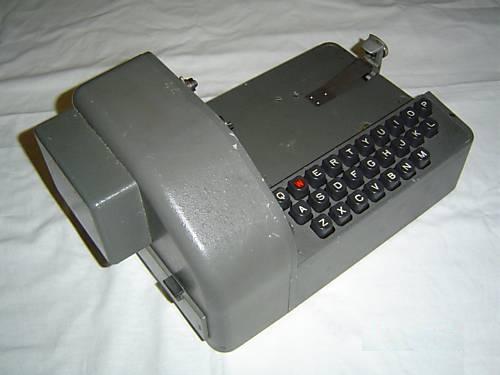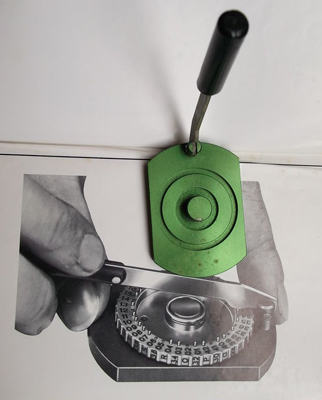The CX-52 was originally produced in a rotor vesion followed
by a random paper tape (RT) reader version (CX52RT 200Type32) Both were
made in Sweden by AB Cryptotenik, Sweden for Crypto AG in Zug, Switzerland.
So what is the basic difference between the Hagelin C-52 and
CX-52? - It's the way the pin wheels step. On the C-52 model, the
stepping is somewhat similar to the one on the C-38 (M-209). On the CX
model, the stepping depends on settings of the pins and the lugs on the
drum. They also have different wheels, where the C-52 has a selectable
set of 12 different pinwheels (more or less co-primes) and the CX has normally
6 identical pinwheels. Nonetheless, there are many customized versions
of the C(X)52.
Cranking the side lever operates the machine but an additional keyboard
unit, motorized this action thus increasing the throughput of the machine.
The lubricating plan can be seen on the top face of the keyboard unit.
Please note the image with the red border is only to show the machine with
its matching keyboard unit, the B52. When the CX-52 machine is used with
the B52 keyboard it's known as the BC52.
Ralph Simpson comments on the C-52.
"All the articles on the internet that say the C-52 has "irregular"
wheel movements are incorrect. Most say that the CX-52 has more irregular
wheel movement. What all these article share is a lack of details about
exactly what is different between these devices. The truth is that the
C-52 has regular and fixed wheel movements!
There are many different versions of these devices, but the CX-52
has lugs on the wheel movement bars which gives irregular wheel movements
which is settable by a daily key. The C-52 has 5 wheel movement bars with
fixed teeth, so there is no chance to set a different daily key. Lugs do
not work on these bars.
In fact, my C-52 has 3 of the 5 bars disabled! The other two wheel
movement bars move wheels 1 and 2 one position and the last 4 wheels 2
positions for every letter entered. Period. No changes allowed, unless
you go through the effort of replacing the bars. But my drum will still
disable 3 of the bars, so wheel movements will be limited to only 2 bars.
So the movement is not one position for each key entered, like the
earlier devices, but as regular as can be. Various models of the C-52 may
have other wheel movements, but these wheel movements may have been shared
with the NSA or if the NSA had to break it, they only needed to do that
once. So wheel movement added zero cryptologic strength to the C-52! This
was step one in the Gentlemen's Agreement. Step two was writing the user's
manual to limit the variability of the lugs and pins".
Mark Sims offers his advice for CX52 ink rollers. "Another useful
bit of info for M-209/CX-52/C-446/BC-543 users is a good source of ink
rollers for the machines. Most office supply stores carry the NuKote
NR-40P ink roller for calculators. It is also numbered EA770R,
CP-16, or IR-40 by other manufacturers. It is used by over 100 different
calculators.
The ink element is the exact inside and outside diameter as the M209/CX52/BC543
ink roller, but about 1/8" longer. It is very easy to modify
the calculator roller for use with the cipher machines. Wear gloves,
it's incredibly messy and the roller gushes ink at the slightest provocation.
First snap the roller/axle out of the "U" shaped clip. Next
take the roller off of the axle. I have found it easiest and cleanest
to cut the end of the axle off first. I use a pair of diagonal
wire cutters. Next trim the roller with a razor blade or surgical
scissors to 3/8" long. I have found it easiest to get a clean
square cut with the surgical scissors. Finally the roller needs
the small brass axle from a real roller or you can cut one off of a piece
of 3/32" O.D. brass tubing from a hobby shop".
Mark Sims <holrum(at)hotmail.com>
For more on the C-52 and CX-52 please refer to the web site of Dirk
Rijmenants.
Contributors and Credits:
1) Dirk Rijmenants <DR.Defcom(at)telenet.be>
2) Frode Weierud <Frode.Weierud(at)cern.ch>
3) Klaus Kopacz <ibk_mail(at)gmx.de>
4) Ralph Simpson ralphenator(at)gmail.com>
5) Gorka Luis Martinez Mezo [glmm2001(at)gmail.com]












